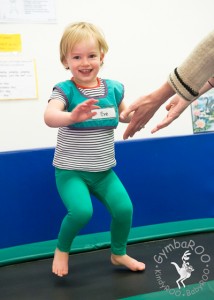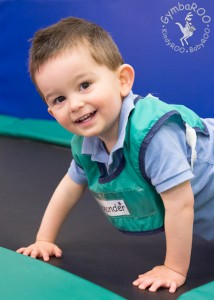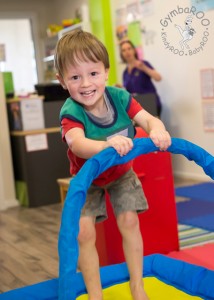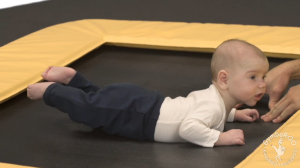Join the thousands of parents already raising smarter, happier babies with our online baby classes: The Active Babies Smart Kids series. Click here.
GymbaROO-KindyROO kids are excelling academically, emotionally, in leadership roles and on the sporting field. Find us at: GymbaROO-KindyROO
I grew up in a neighbourhood with loads of kids. As was done in those days, much of our play was on the street and venturing from one family backyard to the next. We did however spend a larger proportion of this barefoot and carefree time at one particular house – it was the only house on the street with a trampoline. No doubt this choice was primarily a result of the endless hours of fun the trampoline provided. Though, a point to consider, is that during our early years we generally crave activities that are developmentally good for us and the benefits of ‘the bounce’ are numerous. Perhaps our gravitation towards that springy surface was driven as much by our developing brains as by our need to have fun!
You will find trampolines in use during all our GymbaROO and KindyROO classes. Here is why.
What’s in a bounce?
Vestibular stimulation
 Whether being gently bounced or repeatedly jumping, trampolines are providing our little ones with vestibular stimulation. The vestibular system is centred in the inner ear and it ‘talks’ directly to the brain via a key nerve pathway. It controls the sense of movement and balance and plays a very important role in child development. Directly or indirectly, the vestibular system influences nearly everything we do. It is the unifying system in our brain that modifies and coordinates information received from the other senses. The stimulation provided by trampoline use during the earliest years, helps to develop a well functioning vestibular system.
Whether being gently bounced or repeatedly jumping, trampolines are providing our little ones with vestibular stimulation. The vestibular system is centred in the inner ear and it ‘talks’ directly to the brain via a key nerve pathway. It controls the sense of movement and balance and plays a very important role in child development. Directly or indirectly, the vestibular system influences nearly everything we do. It is the unifying system in our brain that modifies and coordinates information received from the other senses. The stimulation provided by trampoline use during the earliest years, helps to develop a well functioning vestibular system.
Sensory input, body awareness and sensory integration
 Bouncing on a trampoline stimulates nearly every sense, leading to an abundance of brain activity. As both visual and auditory functions are directly governed by the vestibular system, bouncing aids the development of vision, visual-motor skills, hearing and auditory-motor skills. Trampolines also provide a wealth of proprioceptive input, (information from the muscles and joints) and kinaesthetic awareness, (information about movement and navigating one’s body through space). This input is crucial for the development of good body awareness, (knowing where my body parts are and how they can move) and spatial awareness, (where I am in space, what direction am I moving in). Receiving simultaneous messages from the senses, encourages sensory integration – the ability of the brain to organise these incoming messages and integrate the body’s systems to respond appropriately.
Bouncing on a trampoline stimulates nearly every sense, leading to an abundance of brain activity. As both visual and auditory functions are directly governed by the vestibular system, bouncing aids the development of vision, visual-motor skills, hearing and auditory-motor skills. Trampolines also provide a wealth of proprioceptive input, (information from the muscles and joints) and kinaesthetic awareness, (information about movement and navigating one’s body through space). This input is crucial for the development of good body awareness, (knowing where my body parts are and how they can move) and spatial awareness, (where I am in space, what direction am I moving in). Receiving simultaneous messages from the senses, encourages sensory integration – the ability of the brain to organise these incoming messages and integrate the body’s systems to respond appropriately.
Muscle tone, strength and posture
Bouncing and jumping exercises nearly every muscle in the body, encouraging muscle strength, core strength and improving posture.
Motor skill development, coordination and balance
 On a trampoline, movement creates a constantly changing centre of gravity. Our babies and children learn to sense these gravitational shifts and to respond accordingly by adjusting their positions. As they move up and down, there is a constant flow of messages between both sides of their bodies and brains, which are busy working together to ensure that balance is maintained. The balance, timing, agility and rhythm developed during these movements improves overall coordination and assists the development and acquisition of new motor skills.
On a trampoline, movement creates a constantly changing centre of gravity. Our babies and children learn to sense these gravitational shifts and to respond accordingly by adjusting their positions. As they move up and down, there is a constant flow of messages between both sides of their bodies and brains, which are busy working together to ensure that balance is maintained. The balance, timing, agility and rhythm developed during these movements improves overall coordination and assists the development and acquisition of new motor skills.
Health, fitness and fun
 According to a NASA study, ten minutes of trampolining is a better workout than thirty minutes of running! At the same time as improving overall fitness, trampolining also improves digestion, blood circulation, stimulates internal organs, promotes lymphatic circulation and drainage and strengthens the immune system. The improved circulation of oxygen to your children’s brains, can help to make them feel more alert and refreshed and improve concentration. Also, the increased oxygen circulation stimulates the release of endorphins – neurotransmitters that can reduce stress and anxiety and promote happiness!
According to a NASA study, ten minutes of trampolining is a better workout than thirty minutes of running! At the same time as improving overall fitness, trampolining also improves digestion, blood circulation, stimulates internal organs, promotes lymphatic circulation and drainage and strengthens the immune system. The improved circulation of oxygen to your children’s brains, can help to make them feel more alert and refreshed and improve concentration. Also, the increased oxygen circulation stimulates the release of endorphins – neurotransmitters that can reduce stress and anxiety and promote happiness!
Learning
All of the afore-mentioned areas of development mentioned above, help to provide solid foundational building blocks for learning. They are the cornerstones of body control, smooth coordinated movement, future academic achievement and behaviour.
In a world where younger and younger children are increasingly attached to inactivity, trampolining is a great way to get out into the fresh air and help brain growth and neurological organisation.
Safety First
Trampolines are one of the best pieces of play equipment you can have in your back yard, however unfortunately trampoline injuries are common. Regardless of the style of trampoline, the checklist and trampoline safety information found by clicking here is a ‘must read’ before you purchase or allow your children on trampolines:
The ‘How To’
At GymbaROO-KindyROO you are constantly given activities to encourage your little one’s development on the trampoline. If you are unable to access a centre, here are a few ideas to get you started.
Babies
With your baby lying on her tummy or back, use your hands to push lightly on the trampoline mat, creating very, very gentle movement. Do this for short periods of time only – five seconds, rest, repeat (x3). I also found the trampoline a lovely place to lie outside in the shade, while my baby lay in the tummy time position on my chest.
 Once babies are older and have gained good muscle control in their arms, shoulders, neck and back, you can be just a little more energetic with the amount of bounce you provide. Again, bounce only for short periods and be guided by your babies’ reactions. They love the ‘bounce, bounce, bounce and STOP’ game on both tummies and backs. Never bounce vigorously and never bounce upright on a trampoline holding your baby.
Once babies are older and have gained good muscle control in their arms, shoulders, neck and back, you can be just a little more energetic with the amount of bounce you provide. Again, bounce only for short periods and be guided by your babies’ reactions. They love the ‘bounce, bounce, bounce and STOP’ game on both tummies and backs. Never bounce vigorously and never bounce upright on a trampoline holding your baby.
Toddlers to 2 years
These little bundles of energy just love being bounced gently in any position – lying on backs, fronts, sitting and standing. Again, never bounce them vigorously. Often at GymbaROO/KindyROO we use trampolines with holding bars, (or parents hands), to help toddlers develop the coordination, balance, timing, rhythm and strength needed for the upcoming skill of jumping.
2 to 5 years
A whole new world of learning opportunity opens up once children have mastered independent jumping. A trampoline can be used as a very effective and engaging tool for learning as you can now include games that involve thinking and moving, a skill that is essential of all learning, both in the classroom and on the sporting field. Try these:
- Jump and clap each time you land.
- Jump forwards and backwards over a line in the middle of the trampoline.
- Jump clap and turn around.
- Jump three times and stop.
Bindy Cummings is a teacher, GymbaROO early childhood neurodevelopmental consultant and early childhood development lecturer. She is the Editor of GymbaROO’s ‘First Steps’ magazine. More on Bindy Cummings here.
Article images 1, 2 and 4 by Studio Z Photography.
GymbaROO-KindyROO
Thousands of parents, babies and children are presently involved in our programs and creating rising stars. GymbaROO-KindyROO kids are excelling academically, emotionally, in leadership roles and on the sporting field. Come join all the fun and learning! “GymbaROO – The best decision I ever made for my child.” Classes from 6 weeks old – 7 years GymbaROO KindyROO
Active Babies Smart Kids – Online Baby Classes
GymbaROO-KindyROO’s online series of baby classes is taking the parenting world by storm! It is highly recommended by doctors, paediatricians, early childhood experts and the Maternal Child and Family Health Nurses Association. This series is being called: “The essential guide for parents”. Join the thousands of parents already playing with their babies from birth, in the best way for brain and body development and laying crucial foundations for future learning. What happens in the first year, not only matters, it matters a lot! Introductory video below.
Click here: Active Babies Smart Kids online series
Try the first episode FREE: Tummy time + baby fun and development class 1
Enjoy the following GymbaROO-KindyROO articles
GymbaROO-KindyROO: Who, what, where, why and how
All about GymbaROO-KindyROO’s online baby classes for parents and babies: Active Babies Smart Kids
How to raise a smarter, happier baby
Why active babies make smart kids
Become a GymbaROO-KindyROO franchisee
Dads make a difference. The important role fathers play in baby and child development.
Why creeping and crawling matter.
Get active with your children, the payoff is immense!
How diet affects brain development.
Tummy time. Free online video.
To my elected childcare, preschool or school: Please include a GymbaROO sensorimotor program.
Click here for more GymbaROO-KindyROO article choices

